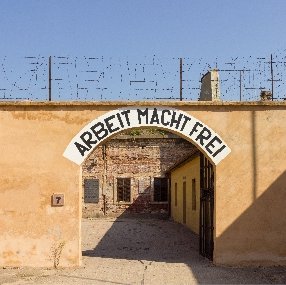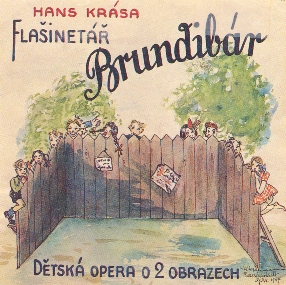During World War II, reports circulated that the Nazis were exterminating Jews. Theresienstadt, a concentration camp in what was Czechoslovakia, played an important role in their efforts to refute these reports. In September 1944, they turned this one camp, briefly, into a model town, filmed the results of this imposture to prove how well they treated the Jews and invited the Red Cross to inspect it.
Realizing the propaganda value of the artistic endeavours by the inmates, a central feature of the film was a performance of the children's opera, "Brundibár" (meaning Bumblebee), written by Czech composer, Hans Krása.
Two weeks after the inspection, transportation from Theresienstadt to Auschwitz and other destinations in the East began. A few members of the cast survived, as did the opera.
How did all this come about?
The opera was originally written by Krása (libretto by Adolf Hoffmeister) in 1938 as an entry for a children's opera competition sponsored by the Czechoslovak Ministry of Education. Before a winner could be announced, the country was occupied by Nazi Germany. However, rehearsals for the opera began in July 1939 at the Jewish-Zionist orphanage, Hagibor near Prague. Before he could hear the work performed, Krása was arrested and eventually deported to Theresienstadt (Terezin in Czech). As Jewish cultural activities were forbidden, two secret performances were managed before mass transportation of Bohemian and Moravian Jews to Theresienstadt had started. Several of Krása's collaborators including some child actors in these performances followed him to Theresienstadt.
Theresienstadt, a former 18th century Austrian fortress, lies 65 kilometres from Prague and here, Krása became head of musical activities of the camp's Freizeitgestaltung (leisure time activities) set up by the Nazis to exploit the propaganda value of such activities in their "model" concentration camp. Under Krása's direction and as a need for distraction, outstanding levels of musical creativity were achieved.
In July 1943, the score of Brundibár was smuggled into the camp by Rudi Freudenfeld. A new orchestral arrangement was written by Krása reflecting the instruments available in the camp; flute/piccolo, clarinet, trumpet, guitar, side drum and bass drum, piano, four violins, cello, double bass and accordion. Under the direction of Rafael Schächter, auditions were held from which a cast was chosen. František Zelenka was appointed stage director with the Viennese choreographer, Kamila Rosenbaum as assistant. Schächter was too busy with other musical projects to conduct so the position was given to Rudi Freudenfeld.
Initially, the main roles were selected as follows:
- Pepíček .... Pintǎ Mühlstein
- Aninka .... Greta Hofmeister
- The Cat .... Ela Steinova
- The Sparrow .... Stefan (Rafi) Herz-Sommer
- The Dog .... Zdeněk Ornest
- Brundibár .... Honza Treichlinger
Altogether, the Terezin version of the opera was performed fifty five times, the premier being on 23 September 1943 in the hall of the Magdeburg Barracks in the camp. The last performance, put on for the camp's inspection by the International Red Cross, was in September 1944. For this, the production was moved to the large Sokol Hall outside the camp. Stage Designer, František Zelenka was given everything he needed to improve the set and costumes. The final scene was captured for the Nazi propaganda film "Theresienstadt - eine Dokumentarfilm aus den jüdische Siedlungsgebiet".
There were to be no more performances in the camp as the transportations east began. Krása was taken to Auschwitz where he was murdered on 17 October 1944.



